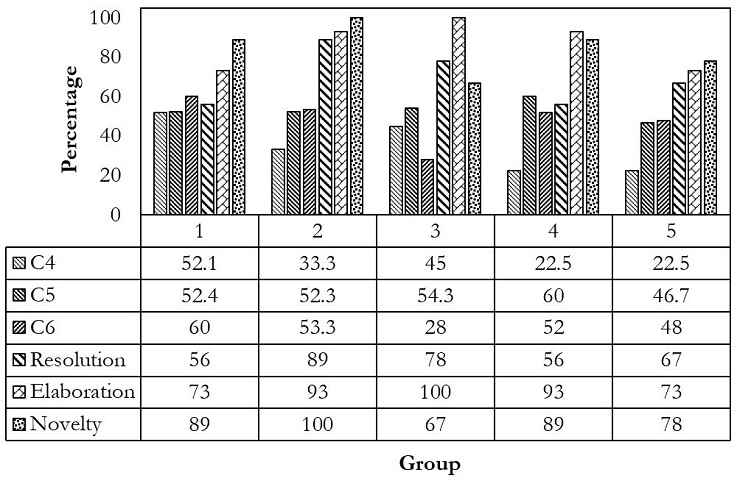
The Effect of STEAM-based Learning on Students’ Concept Mastery and Creativity in Learning Light And Optics
Abstract
Full Text:
Download PDFReferences
Anderson, L. W., & Krathwohl, D. R. (2001). A Taxonomy for Learning, Teaching and Assessing (A Revision of Bloom’s Taxonomy of Educational Objectives). United States: Addison Wesley Longan, Inc.
Baek, J.-E., & Yoon, M.-B. (2016). Development and Application of STEAM Education Program Based on Robots: Through a Theme-Based Robot Soccer. International Journal of Computer Science and Information Technology for Education, 1(1), 27–34.
Besemer, S. P. (2000). Creative product analysis to foster innovation. Design Management Journal (Former Series), 11(4), 59-64.
Besemer, S. P., & Treffinger, D. J. (1981). Analysis of creative products: Review and synthesis. The Journal of Creative Behavior, 15(3), 158-178.
Bloom, B. S. (1984). The 2 sigma problem: The search for methods of group instruction as effective as one-to-one tutoring. Educational researcher, 13(6), 4-16.
Creswell, J. W. (2012). Educational research: Planning, conducting, and evaluating quantitative and qualitative research. Educational Research (Vol. 4). United States: Pearson. https://doi.org/10.1017/CBO9781107415324.004
Fraenkel, J. R., Wallen, N. E., & Hyun, H. H. (2011). How to design and evaluate research in education. New York: McGraw-Hill Humanities/Social Sciences/Languages.
Gurteen, D. (1998). Knowledge, creativity and innovation. Journal of knowledge Management, 2(1), 5-13.
Hake, R. R. (1998). Interactive-engagement versus traditional methods: A six-thousand-student survey of mechanics test data for introductory physics courses. American journal of Physics, 66(1), 64-74.
Henriksen, D. (2014). Full STEAM ahead: Creativity in excellent STEM teaching practices. The STEAM journal, 1(2), 15.
Henriksen, D., Mishra, P., & Fisser, P. (2016). Infusing Creativity and Technology in 21st Century Education: A Systemic View for Change. Journal of Educational Technology & Society, 19(3).
Kim, D. H., Ko, D. G., Han, M. J., & Hong, S. H. (2014). The Effects of science lessons applying STEAM education program on the creativity and interest levels of elementary students. Journal of the Korean Association for Science Education, 34(1), 43-54.
Kim, S. W., Chung, Y. L., Woo, A. J., & Lee, H. J. (2012). Development of a theoretical model for STEAM education. Journal of the Korean Association for Science Education, 32(2), 388-401.
Kim, Y., & Park, N. (2012). Development and application of STEAM teaching model based on the Rube Goldberg’s invention. In Computer science and its applications (pp. 693-698). Springer, Dordrecht.
Kong, Y. T., & Huo, S. (2014). An Effect of STEAM Activity Programs on Science Learning Interest. Advanced Science and Technology Letters, 59, 41–45.
O'Quin, K., & Besemer, S. P. (2006). Using the creative product semantic scale as a metric for results‐oriented business. Creativity and Innovation Management, 15(1), 34-44.
Pratiwi, W. N. W., Rochintaniawati, D., & Agustin, R. R. (2018). The Effect of Multiple Intelligence-Based Learning Towards Students' Concept Mastery and Interest in Matter. Journal of Science Learning, 1(2), 49-52.
Shidiq, A., Rochintaniawati, D., & Sanjaya, Y. (2017). The Use of Self Construction Animation Learning Software to Improve the Students Concept Mastery on Structure and Functions of Plants. Pancaran Pendidikan, 6(3).
DOI: https://doi.org/10.17509/jsl.v2i1.12878
Refbacks
- There are currently no refbacks.
Copyright (c) 2018 Authors

This work is licensed under a Creative Commons Attribution-ShareAlike 4.0 International License.


Jl. Dr. Setiabudhi 229 Bandung 40154, West Java, Indonesia











